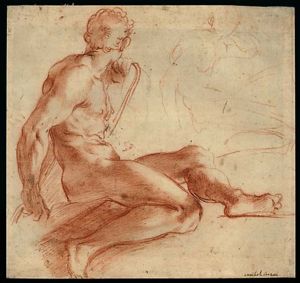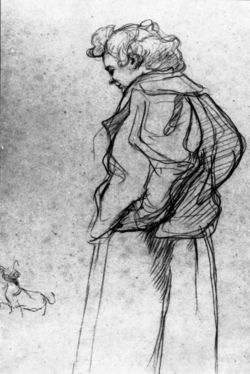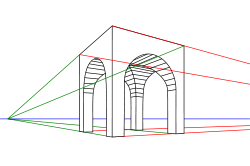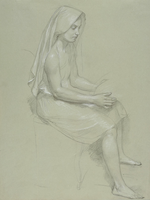Drawing
2008/9 Schools Wikipedia Selection. Related subjects: Art
Drawing is a visual art which makes use of any number of drawing instruments to mark a two-dimensional medium. Common instruments include graphite pencils, pen and ink, inked brushes, wax colour pencils, crayons, charcoals, chalk, pastels, markers, stylus, or various metals like silverpoint. An artist who practices or works in drawing may be referred to as a draftsman or draughtsman.
A small amount of material is released onto the two dimensional medium which leaves a visible mark—the process is similar to that of painting. The most common support for drawing is paper, although other materials such as cardboard, plastic, leather, canvas and board, may be used. Temporary drawings may be made on a blackboard or whiteboard, or indeed almost anything. The medium has also become popular as a means of public expression via graffiti art, because of the easy availability of permanent markers.
Definitions
Drawing is a form of visual expression and is one of the major forms within the visual arts. There are a number of subcategories of drawing, including cartooning. Certain drawing methods or approaches, such as " doodling" and other informal kinds of drawing such as drawing in the fog a shower leaves on a bathroom mirror, or the surrealist method of " entopic graphomania," in which dots are made at the sites of impurities in a blank sheet of paper, and lines are then made between the dots, may or may not be considered as part of "drawing" as a "fine art."
The word 'drawing' is used as both a verb and a noun:
- Drawing (verb) is the act of making marks on a surface so as to create an image, form or shape.
- The produced image is also called a drawing (noun). A quick, unrefined drawing may be defined as a sketch.
In simplistic terms, drawing is distinct from painting, perhaps more so in the Western view; East Asian art, which generally only uses brushes, has historically made less distinction between the two. Critics may praise a painter's ability to draw well, meaning that the shapes, especially of the human body, are well-articulated, or a drawing may be considered painterly.
Adding confusion, similar tools and media may be used in both tasks. Dry media normally associated with drawing, such as chalk, may be used in pastel painting. Drawing may be done with liquid media applied with brushes or pens. Similar supports likewise can serve both: painting generally involves the application of liquid paint onto prepared canvas or panels, but sometimes an underdrawing is drawn first on that same support. Drawing is generally concerned with the marking of lines and areas of tone onto paper, but watercolor painting uses a paper support. Traditional drawings were monochrome, or at least had little colour, while modern coloured-pencil drawings may approach or cross the boundary (if there is one) between drawing and painting.
The term drawing suggests a process and intent that is distinct from the traditional act of painting. While there are drawings that are finished artworks, drawing is often exploratory, with considerable emphasis on observation, problem solving and composition, often as a means of preparation for a painting. In contrast, traditional painting is often a means of execution or finishing an artwork. It is fair to note that modern painters often incorporate methods of drawing in their painting process, particarly in the early stages of a painting.
Subject matter
Drawings may be representational, depicting objects, living beings, or scenes which the artist views, remembers, or imagines. They may be realistic to the point of lifelike resemblance (e.g. traditional portraits), architectural drawing or looser approximations of reality (e.g. sketches), and highly stylized (e.g. cartoons, caricatures, manga), or abstract (e.g. automatic drawing, entoptic graphomania). Drawing may also be a form of heraldic art, with a range of formality from finished works of heraldic art to tricking.
Materials
Paper comes in a variety of different sizes and qualities, ranging from newspaper grade for practice up to high quality and relatively expensive paper sometimes sold as individual sheets. Papers can vary in texture, hue, acidity, and strength when wet. Smooth paper is good for rendering fine detail, but a more "toothy" paper will hold the drawing material better. Thus a more coarse material is useful for producing deeper contrast.
For pen and ink work, typing paper is often used for practice drawings, but heavier paper holds up better. Bristol board makes a hard surface that is especially good for ink or fine detailed graphite drawing. Coldpressed watercolor paper is sometimes favored for ink drawing due to its texture. Tracing vellum is often used for experimenting on top of a pencil drawing, prior to committing a technique to the final page.
Various tools are routinely used in the process of drawing. These include a pencil sharpener, sandpaper, kneaded eraser, blending stumps, and chamois. Other tools that sometimes prove useful are tracing paper, a circle compass, ruler, frisket film, fixative, and drafting tape. The use of an easel or slanted table reduces the distorting effects of perspective. Metalpointing can include copper, bronze, and even gold some of which metals can change colour over time and produce interesting results.
One new tool for drawing is the computer's 'drawing option'. Contemporary artists have broadened the sphere of associations the term 'drawing' encompasses to a number of unconventional drawing media, including performance and multimedia work, employing the branches of trees as drawing instruments, and fashioning images with carbon deposit from smoke.
Aspects of the drawing process
Tone
Shading is the technique of varying the tonal values on the paper to represent the shade of the material as well as the placement of the shadows. Careful attention to reflected light, shadows, and highlights can result in a very realistic rendition of the image.
Blending uses an implement to soften or spread the original drawing strokes. Blending is most easily done with a medium that does not immediately fix itself, such as graphite, chalk, or charcoal, although freshly applied ink can be smudged, wet or dry, for some effects. For shading and blending, the artist can use a blending stump, tissue, a kneaded eraser, a fingertip, or any combination of them. A piece of chamois is useful for creating smooth textures, and for removing material to lighten the tone. Continuous tone can be achieved with graphite on a smooth surface without blending, but the technique is laborious, involving small circular or oval strokes with a somewhat blunt point.
Shading techniques that also introduce texture to the drawing include hatching and stippling. There are a number of other methods for producing texture in the picture: in addition to choosing a suitable paper, the type of drawing material and the drawing technique will result in different textures. Texture can be made to appear more realistic when it is drawn next to a contrasting texture; a coarse texture will be more obvious when placed next to a smoothly blended area. A similar effect can be achieved by drawing different tones in close proximity; a light edge next to a dark background will stand out to the eye, and almost appear to float above the surface.
Layout
Measuring the dimensions of a subject while blocking in the drawing is an important step in producing a realistic rendition of the aertically can be used to measure the angles of different sides. These angles can be reproduced on the drawing surface and then rechecked to make sure they are accurate. Another form of measurement is to compare the relative sizes of different parts of the subject with each other. A finger placed at a point along the drawing implement can be used to compare that dimension with other parts of the image.
When attempting to draw a complicated shape such as a human figure, it is helpful at first to represent the form with a set of primitive shapes. Almost any form can be represented by some combination of the cube, sphere, cylinder, and cone. Once these basic shapes have been assembled into a likeness, then the drawing can be refined into a more accurate and polished form. The lines of the primitive shapes are removed and replaced by the final likeness.
A more refined art of figure drawing relies upon the artist possessing a deep understanding of anatomy and the human proportions. A trained artist is familiar with the skeleton structure, joint location, muscle placement, tendon movement, and how the different parts work together during movement. This allows the artist to render more natural poses that do not appear artificially stiff. The artist is also familiar with how the proportions vary depending on the age of the subject, particularly when drawing a portrait.
Perspective
Linear perspective is a method of portraying objects on a flat surface so that the dimensions shrink with distance. The parallel, straight edges of any object, whether a building or a table, will follow lines that eventually converge at infinity. Typically this point of convergence will be along the horizon, as buildings are built level with the flat surface. When multiple structures are aligned with each other, such as buildings along a street, the horizontal tops and bottoms of the structures will all typically converge at a vanishing point.
When both the fronts and sides of a building are drawn, then the parallel lines forming a side converge at a second point along the horizon (which may be off the drawing paper.) This is a "two-point perspective". Converging the vertical lines to a point in the sky then produces a "three-point perspective".
Depth can also be portrayed by several techniques in addition to the perspective approach above. Objects of similar size should appear ever smaller the further they are from the viewer. Thus the back wheel of a cart will appear slightly smaller than the front wheel. Depth can be portrayed through the use of texture. As the texture of an object gets further away it becomes more compressed and busy, taking on an entirely different character than if it was close. Depth can also be portrayed by reducing the amount of contrast of more distant objects, and also by making the colors more pale. This will reproduce the effect of atmospheric haze, and cause the eye to focus primarily on objects drawn in the foreground.
Artistry
The composition of the image is an important element in producing an interesting work of artistic merit. The artist plans the placement of elements in the art in order to communicate ideas and feelings with the viewer. The composition can determine the focus of the art, and result in a harmonious whole that is aesthetically appealing and stimulating.
The illumination of the subject is also a key element in creating an artistic piece, and the interplay of light and shadow is a valuable method in the artist's toolbox. The placement of the light sources can make a considerable difference in the type of message that is being presented. Multiple light sources can wash out any wrinkles in a person's face, for instance, and give a more youthful appearance. In contrast, a single light source, such as harsh daylight, can serve to highlight any texture or interesting features.
When drawing an object or figure, the skilled artist pays attention to both the area within the silhouette and what lies outside. The exterior is termed the negative space, and can be as important in the representation as the figure. Objects placed in the background of the figure should appear properly placed wherever they can be viewed.
A study is a draft drawing that is made in preparation for a planned final image. Studies can be used to determine the appearance of specific parts of the completed image, or for experimenting with the best approach for accomplishing the end goal. However a well-crafted study can be a piece of art in its own right, and many hours of careful work can go into completing a study.
History: masters of drawing
People have made drawings since prehistoric times. This art form first gained widespread popularity among European artists during the 1400s, when paper became generally available, although underdrawing for paintings already existed. Since that time, each century has produced artists who have created great drawings.
- Masters of drawing in the 1400s and 1500s included Leonardo da Vinci, Albrecht Dürer, Michelangelo, and Raphael.
- During the 1600s, Claude, Nicolas Poussin, Rembrandt, Guercino, and Peter Paul Rubens created important drawings.
- In the 1700s, great drawings were produced by Jean-Honoré Fragonard, Francisco Goya, Giovanni Battista Tiepolo, and Antoine Watteau.
- The masters of drawing during the 1800s included Paul Cézanne, Jacques Louis David, Pierre-Paul Prud'hon, Edgar Degas, Theodore Gericault, Jean Ingres, Odilon Redon, Henri de Toulouse-Lautrec, Honore Daumier, and Vincent van Gogh.
- Great drawings in the 1900s have been created by Käthe Kollwitz, Max Beckmann, Jean Dubuffet, Egon Schiele, Arshile Gorky, Paul Klee, Oscar Kokoschka, M. C. Escher, Jules Pascin, and Pablo Picasso.
Digital illustration
Drawing may also be done on a computer. Computer illustration or digital illustration is the use of digital tools to produce images under the direct manipulation of the artist, usually through a pointing device such as a tablet or a mouse. It is distinguished from computer-generated art, which is produced by a computer using mathematical models created by the artist. It is also distinct from digital manipulation of photographs, in that it is an original construction "from scratch". (Photographic elements may be incorporated into such works, but they are not the primary basis or source for them.)



